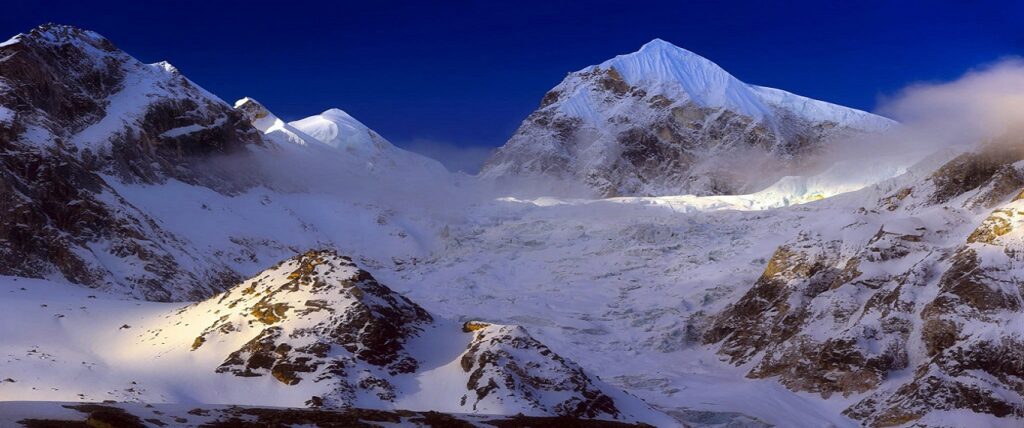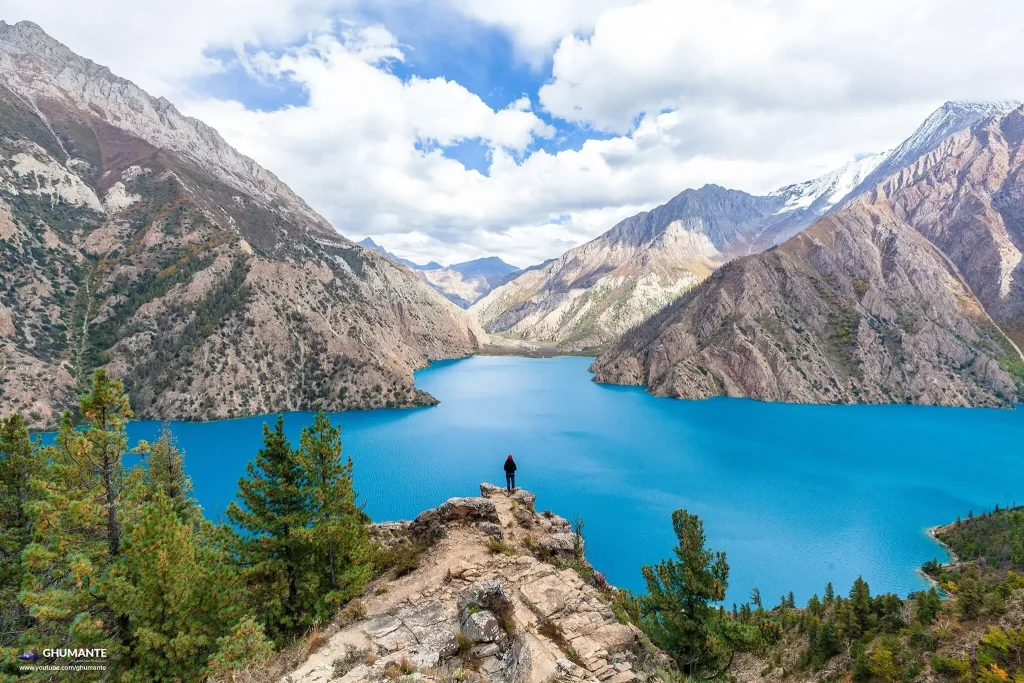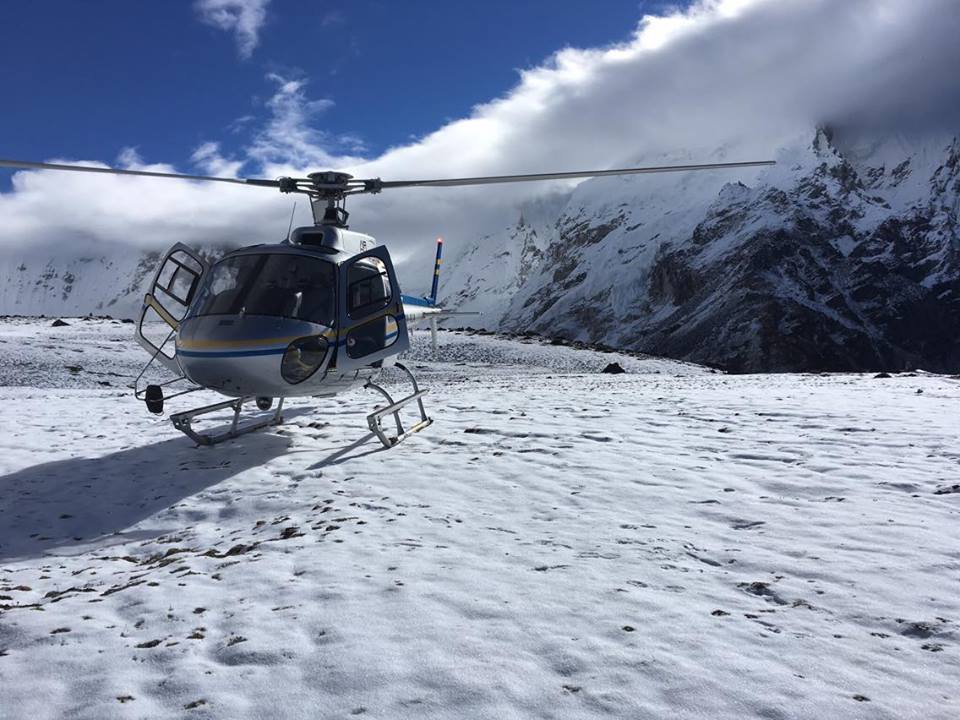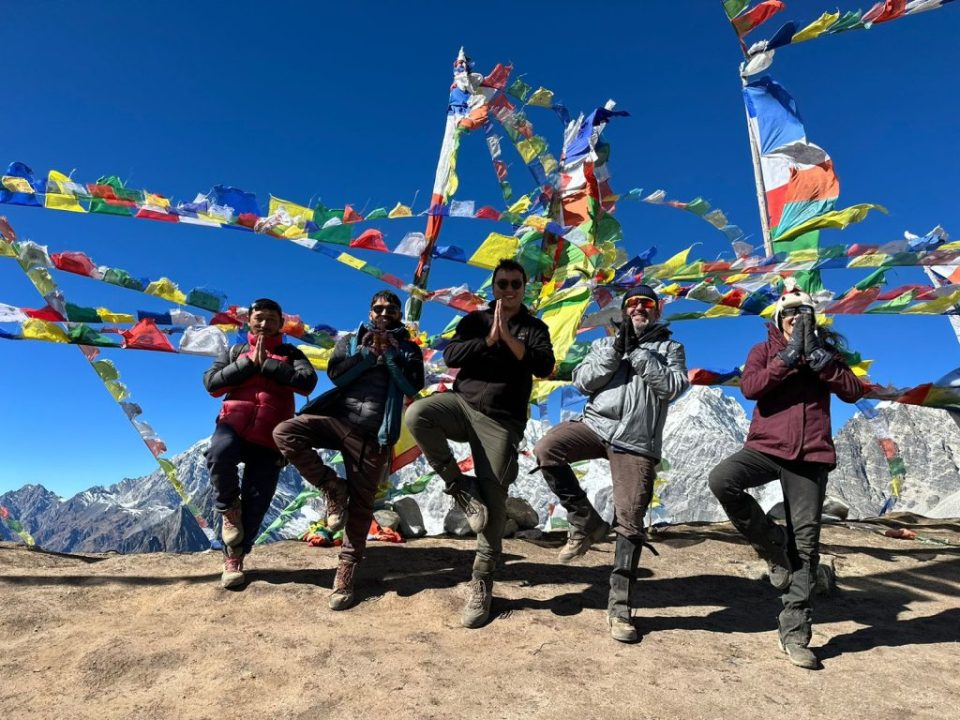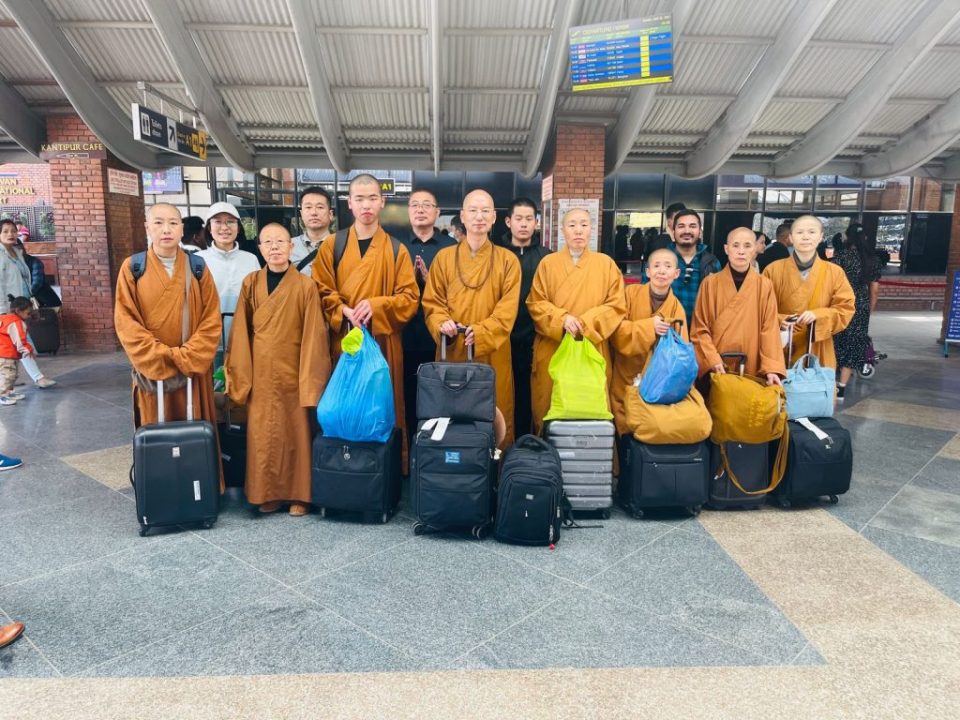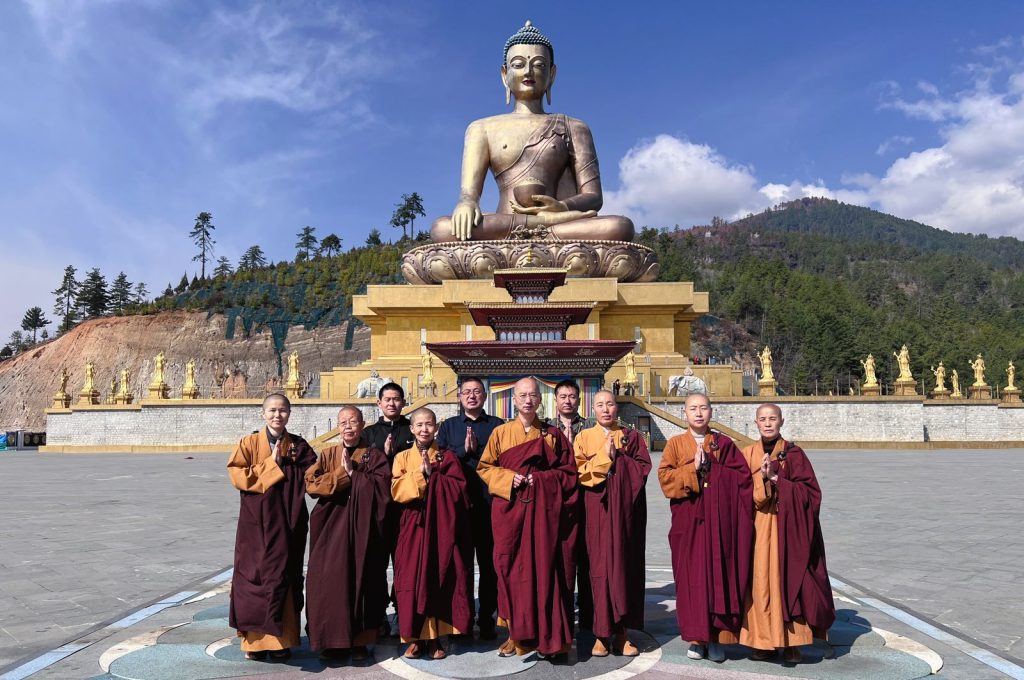Paldor Peak Climbing-16 days
Trip Introduction
Paldor peak is located at the Ganesh Himal’s southeastern end. Bharange is another name for it. It is located to the northeast of Kathmandu. It is located at the intersection of Tiru and Karpu. It is located at a height of 5,903m/19,367ft. It is the ideal combination of trekking and climbing. It is a well-known peak climbing destination. Climbing isn’t all that difficult. We can see Machhapuchhre, the Annapurna range, Mt. Everest, Lhotse, Nuptse, and Shisapangma.
The trek’s main highlight is the summit of Paldor Peak. The trail travels through Langtang National Park, a breathtaking landscape rich in flora and fauna, as well as yak pasture land. There are many plant and animal species to see, including the Himalayan Thar, Gaur, Musk deer, Monkeys, and others. You’ll walk through forests of Spanish oak, blue pine, and various Rhododendron species. You will also visit several Tamang villages and learn about their culture and way of life.
The 15-day trek begins with a seven- to eight-hour drive from Kathmandu to Syabrubesi. Following that, we’ll travel to the beautiful Tamang village, where we’ll learn about their culture and walk-through dense forest and across a suspension bridge. After arriving in Gatlang, we’ll make our way up to the sacred lake of Parvati Kunda. On our way to Somdang, we’ll pass through a Rhododendron Forest and see zinc, copper, crystal, and ruby mines. We will acclimate to Lari before departing for Paldor Base Camp. We will then hike to High Camp, where we will have pre-climbing training. Continue to the summit of Paldor Peak before descending to Base Camp and then the final descent to Syabrubesi.
Trip Facts
| Country | Nepal |
| Duration | 16 Days |
| Maximum Altitude | 5,903m/19,367ft |
| Region | Ganesh Himal |
| Meals | Breakfast, Lunch, Dinner |
| Accommodation | Hotel, Lodge, Teahouses, Camp |
| Grade | Challenging |
| Best season | Mar, Apr, May, Sep, Oct, Nov |
Trip Highlights
- Enjoy the panoramic view of Machhapuchhre, the Annapurna range, Mt. Everest, Lhotse, Nuptse, and Shisapangma.
- Explore the Tamang village and learn about their culture.
- Walk across the Langtang National Park and witness rare animals like Himalayan Thar, Gaur, Musk deer, Monkeys, and Langur.
- Pass through beautiful forests, alpine meadows, and yak pastures.
- Visit the Holy Lake Parvati Kunda and the twin sacred lake white and Black Lakes.
- Explore the Zinc, Ruby, and Copper mines.
- Summit Paldor Peak 5,903m.
Is this trek appropriate for you?
- This trek includes 11 days of strenuous climbing. You’ll be trekking for a minimum of 5 to a maximum of 10 hours per day, reaching elevations of over 5000 meters at times. We cannot overestimate the importance of being in excellent physical shape and health, which requires training before your trip to ensure that you are properly prepared.
- This is the trek for you if you have previous rock climbing or wall climbing experience. It is recommended that you have prior experience with high-altitude trekking.
- The weather in the Himalayas can be unpredictable, you must plan and prepare accordingly, as well as stay up to date on the weather forecast.
- The teahouses, or trekking lodges, where we stay on the trek are very basic, with just basic services. Hot water may not be accessible at all times and may be charged extra, as well as access to electrical outlets for charging electronics. Wi-Fi is available in some areas, although the quality of the connection may be poor.
- The path twists and turns through challenging terrain. At 5,903 meters, you’ll reach the highest peak. Because of the weather, isolation, and high altitude of this walk, it’s critical to take it carefully and stay hydrated.
Itinerary
| Days | Activities | Durations |
| 1. | Arrival at TIA Kathmandu (1,400m/4,592ft) | |
| 2. | Drive from Kathmandu to Syabrubesi (1,500m/4,921ft) | 7-8hrs |
| 3. | Trek from Syabrubesi to Gatlang (2,337m/7,690ft) | 5-6hrs |
| 4. | Trek from Gatlang to Somdang (3,271m/10,760ft) | 6-7hrs |
| 5. | Trek from Somdang to Lari (4,868m/15,971ft) | 5-6hrs |
| 6. | Acclimatization Day | |
| 7. | Trek from Lari to Paldor Base Camp (4,980m/16,338ft) | 6-7hrs |
| 8. | Trek from Paldor Base Camp to High Camp (5,200m/17,060ft) | 5-6hrs |
| 9. | Summit to Paldor Peak (5,903m/19,367ft) and Descend Back to Base Camp (4,980m/16,338ft) | 9-10hrs |
| 10. | Contingency Day for the summit | |
| 11. | Trek from Base Camp to Somdang (3,271m/10,760ft) | 6-7hrs |
| 12. | Trek from Somdang to Gatlang (2,337m/7,690ft) | 6-7hrs |
| 13. | Trek from Gatlang to Syabrubesi (1,500m/4,921ft) | 5-6hrs |
| 14. | Drive back to Kathmandu | 7-8hrs |
| 15. | Rest Day | |
| 16. | Departure |
Itinerary
Departure from : Kathmandu, Nepal
Arrival On : Kathmandu, Nepal
Day 1
Arrival at TIA Kathmandu
Upon arrival at Tribhuvan International Airport (TIA). Our agent will greet you and accompany you to the hotel. Drive to the hotel and check-in. Our guide will come to see you in the evening and give you a brief overview of the journey. At the hotel, we had dinner and stayed the night.
Day 2
Drive from Kathmandu to Syabrubesi
This morning, after you’ve finished your breakfast at the hotel. We will depart for Syabrubesi, a 7 to 8-hour drive away. We’ll be driving through traditional terraced fields and along the mountainside. We will pass through Trishuli, a busy settlement. The path takes you through Naubise, Galchi, Dunche, and finally Syabrubesi. Dinner and Overnight at the Hotel.
Day 3
Trek from Syabrubesi to Gatlang
Today is the first day of our trek, and we will depart for Gatlang after breakfast. We’ll be walking for 5 to 6 hours. To get to Gatlang village, we’ll travel through Yak pastures, lush forests, and waterfalls. We will first cross the Bahun Danda Pass, which will require us to take a narrow and rough path. On the way, we’ll stop for lunch. We will pass through beautiful villages on our way to the small Tamang village of Gatlang. Dinner and Overnight at the Teahouse.
Day 4
Trek from Gatlang to Somdang
We’ll leave for Somdang after breakfast. We’ll be walking for 6 to 7 hours. We’ll make our way to the holy lake of Parvati Kunda. We’ll continue our walk after we’ve explored the area around the lake. To get to Yuri Kharka, we’ll climb a hill and pass through a Rhododendron and Pine Forest. We’ll stop for lunch on the way. Following that, we will walk toward the Somdang River via Khurphu Bhanjyang. After a few hours of walking, we arrive in Somdang, where there is a deep tunnel which used to extract mines such as zinc, copper, ruby, crystal, and tin. It has been closed for many years, but you can still explore the area. Dinner and Overnight at the Teahouse.
Day 5
Trek from Somdang to Lari
We’ll set out for the Lari. We’ll be walking for 5 to 6 hours. Throughout the trek, we will be treated to breathtaking mountain views. We’ll be walking through a Rhododendron Forest. We’ll stop for lunch on the way. We will continue walking on the east side of Ganesh Himal until we reach Lari. Dinner and Overnight at the Teahouse.
Day 6
Acclimatization Day
Today is our acclimatization day in Lari, so we will begin our day a little later than usual. Relax and enjoy your breakfast; we’ll need plenty of rest for our next adventure. Today you can either rest all day or go on a hike around the village. Dinner and Overnight at the Teahouse.
Day 7
Trek from Lari to Paldor Base Camp
We will depart for Paldor Base Camp after breakfast. We’ll be walking for 6 to 7 hours. As we climb higher, we must ascend gradually. Higher altitudes will have less vegetation. On the way, we’ll take in the scenery of the mountains. We’ll stop for lunch on the way. Once we reach the Camp, we will set the tent and rest and drink lots of water. Dinner and Overnight at the Camp.
Day 8
Trek from Paldor Base Camp to High Camp
We will depart for High Camp after breakfast. We’ll be walking for 5 to 6 hours. It is a short walk, but it will be difficult because we will be walking on a snowy path. We will arrive at the High Camp for lunch. After setting the camp, we will freshen up, eat lunch, after that you will have a training period during which your guide will teach you how to use climbing equipment such as an ice ax, jumar, and crampon, as well as some other basic skills. We will become familiar with the necessary equipment and learn basic rope skills. You’ll need to practice to get it right. Dinner and overnight at High Camp.
Day 9
Summit to Paldor Peak and Descend Back to Base Camp
After breakfast, we’ll set out for the summit of Paldor Peak. We’ll be walking for 9 to 10 hours. Today, we must begin our day at a very early hour. To get to the top, we need to properly equip ourselves and follow the instructions. We’ll have to walk on ice and snow. After reaching the summit, we will have a spectacular view of Machhapuchhre, the Annapurna range, Mt. Everest, Lhotse, Nuptse, and Shisapangma. We will explore and enjoy the peace at the top before descending back to Base camp, where we will enjoy hot drinks and enjoy the achievement. Dinner and overnight at Camp.
Day 10
Contingency Day for Summit
An additional day in case severe weather prevents you from summiting on time. This day can also be used in the event of an emergency, such as canceled or missed flights, delays due to minor injuries or weather conditions, and so on. If you keep to your timetable and everything goes according to plan, you can spend the extra day exploring a Sherpa village along the way.
Day 11
Trek from Base Camp to Somdang
We’ll leave for Somdang after breakfast. We will leave for 6 to 7 hours. We’ll walk along the same path. We’ll enjoy the view from the Path. We’ll be going on a walk through a Rhododendron Forest. On the way, we’ll stop for lunch. We arrive in Somdang after a few hours of walking, where there is a deep tunnel used to extract mines such as zinc, copper, ruby, crystal, and tin. Dinner and Overnight at the Teahouse.
Day 12
Trek from Somdang to Gatlang
We’ll leave for Gatlang after breakfast. We’ll be walking for about 6 to 7 hours. As this is the final day of your journey, we will take in the breathtaking scenery along the way. We will walk on the same trail toward Gatlang Village. Following that, we will walk toward the Somdang River via Khurphu Bhanjyang. We will have lunch on the way. To get to Yuri Kharka, we’ll climb a hill and pass through a Rhododendron and Pine Forest. After some hours of walk, we will reach Gatlang Village. Dinner and Overnight at the Teahouse.
Day 13
Trek from Gatlang to Syabrubesi
We’ll leave for Syabrubesi after breakfast. We’ll be walking for about 6 to 7 hours. As this is your final day of travel, we will enjoy the breathtaking scenery along the way. We’ll continue on the same path toward Syabrubesi Village. We’ll be passing through Yak pastures, lush forests, and waterfalls. We’ll start by crossing the Bahun Danda Pass, which will require us to take a narrow and difficult path. We’ll stop for lunch on the way. We will proceed to Syabrubesi. Dinner and Overnight at the Teahouse.
Day 14
Drive back to Kathmandu
Today, after breakfast, we will depart for Kathmandu via the same route, a 7 to 8-hour drive away. We’ll be driving along the mountainside and through traditional terraced fields. We’ll pass through Trishuli, a busy town. The route passes through Syabrubesi, Dunche, Galchi, Naubise, and finally Kathmandu. Dinner and Overnight at the Hotel.
Day 15
Rest Day at Kathmandu
At the Kathmandu Durbar Square, you will be enjoying a delicious breakfast. The remainder of the day is yours to design according to your preferences. You may go shopping or visit one of Kathmandu’s three durbars. Swyambhunath or Bouddhanath can also be visited in the evening for the evening prayer. Go to a Pasupathinath for “Sandhya aarti,” also known as Night aarti, at night. Following that, have a farewell dinner with your teammates. Dinner and Overnight at the Hotel.
Day 16
Departure
The 15-day journey has concluded. Today is your last day in Kathmandu. Our representative will have a short discussion on the trip and take your feedback after a hearty breakfast. Following this session, he will drive you to the airport in our private transportation 3 hours before your trip.
Route Map
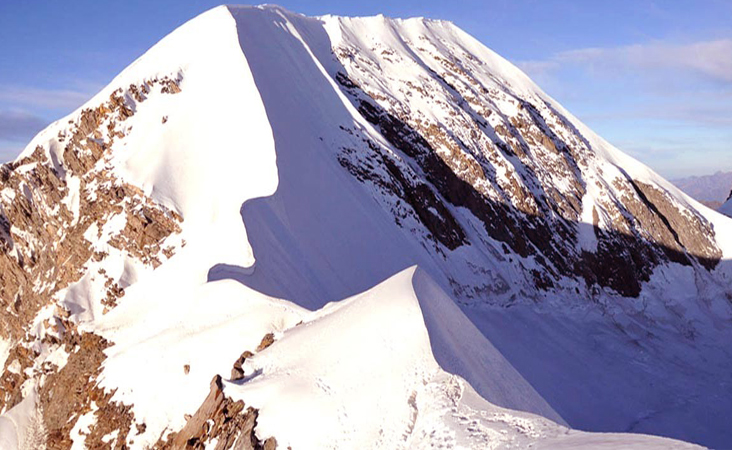
Altitude Map

What's Included
- Arrival & Departure: Airport – Hotel transfer – Airport (Pick Up and Drop on private basis).
- Hotel Accommodation in Kathmandu: 3nights at Star categories hotel on twin sharing on bed and breakfast basis.
- Welcome Dinner and farewell dinner at Nepali culture restaurant.
- Food & Lodging: 3 meals a day (Breakfast, Lunch, Dinner) along with accessible accommodation sharing during the trek.
- Permit: All necessary paper works: Langtang National Park permits, TIMS Card, and NMA Paldor Peak Climbing Permit.
- All government and local taxes if necessary.
- Trekking Map.
- Member transportation: – Road Transportation: Drive from Kathmandu to Syabrubesi and while returning to Kathmandu.
- Drinking: 2 liters of boiled water to carry on thermos per day per member.
- Guide: Government licensed Guide (English speaking) during the trek
- Porter: Porters (2 trekkers: 1 porter) up to 15kg during the trek.
- Insurance: Insurance for all involved Nepalese staff during the trek.
Comprehensive Medical kit
What's Not Included
- Air Fare: International flight airfare (from and to Kathmandu).
- Nepal Tourist Visa fee.
- Extra night in Kathmandu: Extra nights’ accommodation in Kathmandu. In case of early arrival or late departure, early return from Trekking (due to any reason) than the scheduled itinerary.
- Personal Insurance: Travel and high-altitude insurance, accident, Helicopter medical & emergency evacuation. *Mandatory
- Personal Expenses: Telephone calls, Internet, Toiletries, Battery recharge, hot shower, laundry, soft drinks, beer, and any alcoholic beverages.
- Personal Equipment: Clothing, Packing Items or Bags, Personal Medical Kit, Personal Trekking equipment.
- Rescue Evacuation: Medical and emergency rescue evacuation costs if required. (Rescue, Repatriation, Helicopter, Medication, Medical Tests and Hospitalization costs).
Equipment List
What to bring ?
General
Tailor Your Holiday
Everyone has their own preferences in terms of destination, journey time, and budget. As a result, sticking to our plan isn't necessary. We will create a personalized itinerary for you that includes accommodations, transportation, meals, and tour guides. We guarantee you the best Tailor-made Package because this is your trip. You have the option to personalize it, as your liking. Let us Plan together to make your Vacation worth it.
Fixed Departure
Why Travel With Us?
The ideal season to travel
Spring
March: The month of March is ideal for trekking and admiring the spectacular mountain peaks. The Ganesh Himal trekking trail will be crowded with hikers beginning in March. In the Ganesh Himal region, the spring season begins in March, the month of the Rhododendron. Trekking in March will provide you with the most memorable experiences in a pleasant and mild climate. At lower altitudes, the weather is not particularly hot, and at higher altitudes, it is not particularly cold. The views of the mountains are spectacular, and the trail is excellent. Nature can be experienced at its most beautiful.
April: April is the beginning of spring in Nepal, and the weather is ideal for trekking to Ganesh Himal Region. The views are bright and clear at this time of year, and everyone enjoys spring. The surroundings are vibrant and colorful, with rhododendrons in bloom. It is the best time of year to see various bird and butterfly species. During your April trip to Ganesh Himal, the weather is completely in your favor. The moderate heat of the sun, combined with the lack of wind, makes it ideal for trekking. Furthermore, the amount of rain and snow is insignificant.
May: May, the final month of the spring season in Nepal, is much hotter. The Ganesh Himal Region trek in May has the highest temperature of the year. Temperature and weather will vary depending on the altitude throughout the trek. During the day, the weather in the lower sections will be extremely hot. The nights, on the other hand, are tolerable.
Summer
June: June is the coldest time of the summer and has the least amount of rainfall. The month of June is the offseason and therefore less popular for trekking. In the region, June marks the start of the wet monsoon season. The weather is slightly humid, and you can enjoy nature while it is wet and cool. If you enjoy the rain, rainbows, and less crowded trails, this is the month for you. During this month, the air begins to become humid due to continuous rain.
July: Trekking in Nepal in July isn’t always joyful because the heavy rains can block your view of the beautiful mountains you’ll pass through. In July, you will notice that the temperature is not as chilly in the Ganesh Himal Region. As the rain washes away the dust and pollution, the environment opens up and becomes very fresh, and you will be able to enjoy nature despite the chilly weather.
August: In the Ganesh Himal region, August is the off-season for trekking. In August, the monsoon season produces strong rains, especially in lower places. Due to weather-related concerns, most hikers avoid this month. The summer monsoon season comes to an end in August. It rains regularly, and you may feel a little chilly as a result. You should also be cautious because the trails are slippery and the possibility of landslides and avalanches is considerable.
Autumn
September: The monsoon season finishes in September, marking the start of the fall season. The optimum time to trek to Ganesh Himal Trek is in September. The weather and temperature for the Ganesh Himal Trek are ideal. The temperature is pleasant during the day, but it is extremely chilly at night.
October: October is the month that falls between September and November. As a result, it keeps both monsoon rain and winter’s biting cold at distance. The weather is warm and pleasant in October, with clear skies and fresh air. The nights, on the other hand, are a little chilly, with a brisk breeze coming from the campsite. Throughout October, the weather is pleasant, allowing people to enjoy an unobstructed view of the snow-capped peaks. They can also visit bright valleys and interesting scenery of various colors.
November: The last declared peak season for trekking in Nepal is November. Bright, sunny days and beautiful skies characterize November. On the treks, these provide breathtaking, crystal-clear vistas of the mountains. The days are bright and sunny in November. The sky is clear, with perhaps a few stray clouds possible.
Winter
December: In the Ganesh Himal region, December is a rather dry month. It receives fewer than 25 millimeters of rain every year. The Ganesh Himal region is in the shadow of the Himalayas. As a result, December has a lower chance of rain. It is also possible to walk the Ganesh Himal Trek in December. In December, hikers will get a unique perspective of the region.
January: In Nepal, January is in the midst of winter. The higher elevation receives moderate snowfall, whereas the lower elevation is ideal for trekking. During the day, you will feel warm, but as night falls, you will feel cold. In January, these areas receive little to no rainfall. As a result, the skies remain clear and the surroundings appear even sharper. The trails will be covered in snow, so you may need crampons to cross the pass.
February: The Ganesh Himal Region trek in February is an escape from the hustle and bustle of everyday life to a place where all you can see are mountains and scenery. It’s peaceful because February is the coldest month of the year. Most people dislike trekking in the winter because they believe it is extremely difficult.
Drive to Syabrubesi
- The Distance between Kathmandu and Syabrubesi is 122 km.
- Traveling to Syabrubesi by jeep will take around 7-8 hours.
- The route to Syabrubesi from Kathmandu is Naubise – Galchi – Dunche and Lastly Syabrubesi.
Altitude sickness
Altitude sickness is a sneaky monster that may attack even the fittest trekkers. This demand doing everything in your power to prepare for altitude trekking and taking things carefully throughout your journey. With increasing altitude, the amount of available oxygen decreases, which is the primary cause of high-altitude sickness.
The Paldor Peak climbing is a high-altitude trek that needs proper acclimatization. Your body requires time to adjust to thin air, so start at a lower altitude and work your way up. Some of the symptoms of Altitude sickness are:
Early symptoms of altitude sickness
- Increased breathing.
- Increased urination.
- Headache and Restless sleep.
- Periodic breathing at night as a result of altitude.
- Dehydration.
Later symptoms
- Shortness of breath.
- Extreme fatigue.
- Respiratory failure.
- Cerebral edema.
- Coma.
Certain care should be made to ensure that the situation does not worsen. However, if the symptoms worsen, you may need to return to a lower height and seek medical help. There are, however, several other precautions you may take while trekking in the Ganesh Himal Region to lessen your risk of altitude sickness.
- Trekkers can change their bodies by slowly and gradually climbing, as our bodies require time to adjust to the oxygen level. At least one day of acclimatization rest is required for high altitude trekking, and you should go as high as possible before returning to a lower height for the night.
- You should do various strength training exercises such as running, cycling, jogging, push-ups, and going to the gym to acquire strength and stamina for your adventure.
- As the air gets increasingly thin, an increase in elevation reduces oxygen levels, and in the Ganesh Himal Region trek, an increase in altitude also means less vegetation. The consumption of alcoholic beverages, cigarettes, and tobacco decreases the body’s water content.
- The greatest remedy is to stay hydrated at all times. On your walk, instead of drinking cooled water, drink warm water.
- Diamox is the most effective altitude sickness medication; thus, you should bring a subscription with you on the trek. However, you should consult with your physician to see whether it is advantageous.
Things to know before trekking to Ganesh Himal Region.
Drinking-Water.
Trekkers must hydrate their bodies at a higher altitude than in lower elevations to avoid dehydration and altitude sickness. Lack of fluid can be the main hindrance during the trek. You should hydrate your body with at least 3-4 liters of water daily (Tea, soup, or normal drinking water).
There is no difficulty to find water in the trek to Ganesh Himal Base Camp. Tap water, river water is mostly available throughout the trail but is not safe to drink. You are not used to the local water, so drinking it may result in Diarrhoea. So, unless there is an emergency, not drink stream/river water without boiling or treating it with purifying tablets or water filters (Steripen).
Besides that, the other places to get drinking water are local teahouses and lodges, so whenever you get to any teahouses/lodges on the trail grab the opportunity to refill your water bottle and treat it before drinking. The teahouse also provides boiled drinking water. Coldwater is provided free of charge, but for boiled water, you have to pay a certain amount. For bottled water, as you get higher the cost will get expensive. It will cost you up to 1$-1.5$ per bottle/liter.
Every day, carry enough water for the day before beginning the trek. In and beyond the Paldor Peak Base Camp there are no water resources. So that, from the base camp to summit peak you have to melt the snow for water and treat it to make it drinkable. But not to worry, if you are traveling from any agency like us, you’ll be provided hot water 2-3 liter per day. Therefore, we recommend you use a Reusable water bottle or water pouch favorable for both hot and cold water. You can also use a filtration system like LifeStraw.
Here are some ways that you can use to make the water drinkable.
- Boiled water
Boiling water is the best way to purify the water. As we are climbing to a higher altitude you need to boil the water for about 3-minute and season it with a pinch of salt before drinking. You can get free tap water in the teahouse/guesthouses but for boiled water, it cost a certain amount.
- Purification tablets or electrolyte powder.
Purification tablets like chlorine or iodine tablets are commonly used tablets by trekkers to disinfect the water. 1 tablet is enough for a liter of water. It takes around 30 min for the tablets to dissolve and become drinkable. Water, purify by tablets may leave a taste in your mouth.
Electrolyte powder is another option. Electrolyte powder is a better way to purify water than tablets because electrolyte powder contains minerals such as salt, Potassium, Magnesium, which are important for your body during the trek.
- UV Light water purifier/ SteriPEN.
It is a simple, effective, economic, and environment-friendly way to purify water. It kills the bacteria and virus within 10 sec by exposing them to ultraviolet light using SteriPEN, without changing the flavor of the water. This is a highly recommended means of purifying water (a one-time investment).
Electricity and Internet facility.
Electricity facility.
You won’t be in darkness during the trek to Paldor Peak. The whole region is either powered by Hydroelectricity or a Solar panel/ battery.
Most of the area is powered by local hydroelectricity so there will be a charging socket in your hotel/lodge’s rooms. However, the village in some upper areas relies on Solar panels or solar power batteries for electricity that is enough to light the bulbs and charge small devices. In those places, there will be no charging socket in your room. There is a commonplace for charging usually in the dining area. You might be able to charge the mobile set, camera battery, and power bank from thereby paying a price. Solar battery power might harm your device, so charge it at your own risk. As a result, it is recommended that you bring a power bank and spare camera batteries that will last the duration of your trek.
Internet Facility and Network Service
This region does have Wi-Fi/internet access, but it lacks a stable connection as you climb to higher altitudes. Most of the lodge/ teahouses have Wi-Fi availability. Some provide it free of charge and some charge an amount. However, you can also connect to the internet via. your cellular network’s data package.
Both NTC and NCell cellular network is available in this region but at higher altitude, some places may be out of reach of any mobile network. So, during that time you will be disconnected from your loved ones. However, you will be connected to a mobile network most of the time. NTC cellular service is most preferred over NCell because NTC provides better service and signal connectivity up to Paldor Base Camp, compared to NCell.
Buy the sim card from the stores in Kathmandu for 1USD. By taking data packages you can use the internet service up to Paldor Peak Base Camp when the mobile network catches a signal. It is not guaranteed that your mobile network will have a signal all the time. Or buy a satellite phone.
| Buy NTC data package
Dial*1415# |
Cost of data package in NTC:
-14GB=7$ (Valid up to 28days -30GB=15$ (Valid up to 90 days) |
Check balance
Dial *1415# |
| Buy NCell data package
Dial *17123# and select. |
Cost of data package in NCell:
-15GB=10$ -25GB= 12$ (Valid up to 30 days) |
Check balance
Dial*101# |
Document needed to buy a sim card.
For Foreigner = 1 passport size photo, Passport photocopy, or valid identity card.
For Nepali = 1 Passport size Photo, Photocopy of Citizenship.
Some useful tips to reduce the extra usage of electricity.
- Extra batteries for the camera.
- Power bank with 5000-10000mAh.
- The solar charger and solar lamp (LuminAID Nepal lamp)
- If possible, less usage of a device with low brightness, GPS off, and airplane mode.
Essential Backpack items for the Paldor Peak climbing trek.
The bag of a trekker also reveals the trekker’s level of experience. A good trekker should be a smart backpacker. You should be pre-prepared for the things that you need in the trek.
Here are some of the things that you need to take with you for the trek.
Travel documents
- Airline tickets with the itinerary.
- Travel insurance policy documents.
- Original valid passport.
- Copies of passport.
- Passport-sized photos.
- Nepalese cash.
- Travel permits.
Clothing
- A pair of waterproof trekking shoes or hiking boots.
- A pair of flip flop slippers or running shoes.
- A pair of mountaineering boots for climbing.
- 2-3 sets of thermals (leggings and tops)
- 4-5 pairs of hiking long sleeve shirts or tops.
- Pairs of trekking shorts and down pants.
- Fleece jumpers or a set of tracksuits.
- Good quality windproof down jacket.
- Lightweight waterproof jacket with large hood and pants.
- Insulated hard-shell jacket.
- Neck gaiter, leg warmer, and packet of pocket hand warmers.
- 5-6 pairs of quick-dry wool socks/liner socks, underwear, sports bra.
- Pair of inner and outer gloves.
- Knitted Hat, sun cap, beanie, or bandana.
- Glacier Sunglasses/ eyeshade for trekking and full coverage eyewear for climbing peak (Eye and nose).
Trekking equipment
- Waterproof trekking bag of 40-50liter and Rucksack of duffel bag (if your backpack is not enough for all your item and need a potter).
- Reusable water bottle (both hot and cold) of at least 2-3litre.
- A sleeping bag and sleeping bag liner.
- Trekking stick/ poles.
- Route Map.
- Ice Crampons
- LED Headtorch or solar lamp (LuminAID Nepal lamp is best as it is solar-charged and very much portable)
- Stuff sacks, paper bags.
- Plug adapter, Charging appliances, Power bank, Camera batteries.
- Pocket knife.
- Travel Wallet.
Peak Climbing equipment
- Ice Axe.
- Pair of ice/mountaineering crampons.
- Harness.
- Screw gate Carabiners (2lock, 2 unlock).
- Ascender (jumar)and Descender (figure of 8).
- Plastic mountaineering boots.
- Helmet.
- Snow bar.
- Climbing Rope.
- Ice hammer.
- Ice screw.
Toiletries
- Rolls of Toilet paper, wet wipes, and tissue.
- Medium-sized quick-drying towel.
- Toothbrush and toothpaste.
- Hand sanitizer.
- Sunscreen, lip balm, body lotions.
- Deodorants.
- Portable mirror.
- Shampoo and soap.
Personal First Aid Kit
- Antibiotics
- Painkillers, Paracetamol, ibuprofen, aspirin, Nicole
- Sanitary pads
- Bandage.
- Anti-inflammatory spray.
- Anti-Nausea tablets.
- Anti-diarrhea pills or power.
- Altitude sickness tablets- Diamox
- Water purifying tablets or electrolyte powder.
- Mosquito and Insect Repellent.
- Salt or anti-leech oil (If traveling in the rainy season, July- Aug)
- Earplugs
You can buy or hire trekking clothes and equipment in Thamel, Kathmandu. If you are buying it, you have to allow an extra day for shopping; however, if you are hiring it, you must inform us in advance so that we can arrange it before you arrive in Kathmandu. This way you can reduce the weight of your luggage and save time and money.
Branded, New as well as fake, and used trekking clothes and equipment are available around the Thamel area at a reasonable price.
Accommodation, Meal, and Transportation
We will accommodate in star hotel during our stay in Kathmandu.
During the trek, we will accommodate on Basic Hotels/ Lodges/ Teahouses/camps.
Meal
During the trek, we will provide you three-time meals. You can choose from the given menu.
Breakfast– French toast, Pancakes, Bread butter, Tibetan bread/ Chapati, Boiled Egg, Omelets, Tsampa porridge, Oatmeal, Tea/ Coffee, etc.
Lunch– Dal Bhat set (Rice, Vegetable curry/ Meat curry, Lentils, Pickle, Salad, Papad), Fried rice, Chowmein, Thukpa-Tibetan Noodle soup, Garlic soup, Noodles soup, Mo; Mo (dumplings), Potato items, Macaroni, Sandwiches, Tenduk, etc.
Dinner– Dal Bhat set (Rice, Vegetable curry/ Meat curry, Lentils, Pickle, Salad, Papad), Fried rice, Chowmein, Thukpa-Tibetan Noodle soup, Garlic soup, Noodles soup, Mo: Mo (dumplings), Potato items, Macaroni, Sandwiches, Tenduk, etc.
Besides these, there are a variety of other options of food. You can buy it from your pocket.
Transportation
By Bus- from Kathmandu airport to hotel and vice-versa.
From Kathmandu to Syabrubesi and while returning.
Guide and Staff Arrangements
Throughout the trek, all your activities will be handled by our well-qualified and professional staff. They will do all the escorting. As this is one of the tricky treks, we are providing you with a highly experienced and licensed guide with fluent English speaking and has excellent navigation and technique of rope fixing skills. They will accompany you from Kathmandu and guide you throughout your Paldor Peak climbing journey. Each group of 4-5 trekkers will be assigned an assistant guide, as well as a porter for two trekkers (2*15kg =30kg). If your luggage weighs more than 15kg you will be provided a porter individually but you will be charged for 2 people.
All our lead guides, assistant guides, and potters are well professional and experienced. So, we hope for your respect and cooperation with them throughout the trek.
A typical day on the Paldor Peak trek.
Every day will begin with the ringing of your alarm clock at 6 a.m. and a knock on your door from your guide with the invitation of breakfast. Get up, have breakfast, pack your backpack and get ready to start your day’s walk by 7 a.m. We need to start our trek early to reach our overnight destination on time/before dawn.
You’ll walk along the lush forest of Rhododendron, Pine, Oaks, and bamboo; clicking photos; creating memories; interacting with your guide; hearing each other’s stories. Lunch will be served at a local teahouse/guesthouse in the afternoon. Having the flavorful Dal Bhat and an hour of rest, we will proceed to our overnight destination as per the itinerary.
On arrival at the destination, check into your accommodation. Get freshen up and some rest. As every teahouse/lodge where we stay has a common dining area, there you will get to meet other travelers. You can sit there, laugh at each other stories, play cards, sing songs, play music, and have a good time. This will help you forget all the tiredness of the day. Later in the evening, you will have your dinner together. After dinner, your guide will give a short briefing about the next day’s trek regarding when you must get up when we have to start our trek the next day, where we will stay the next day, how many hours we have to walk, and so on.
During this trek to Paldor Peak, you will walk for a minimum of 5 hrs to a maximum of 10hrs in a day. You will walk on the off-beaten path over the dense forest of Langtang National. During this trek, you pass through the amazing George, Mountains, Terraced farmland, small springs/ streams, and villages of Tamang. You’ll see the zinc, copper, crystal, and ruby mines. During the acclimatization day, hike around the small peaks/viewpoints and prepare your body to deal with any difficult walk. Before climbing the peak, you will be taught how to walk/how we have to move while climbing the peak. You have to study and practice well because your life and success depend upon your skill, knowledge, and endurance. At night enjoy the view of sparkling stars floating in the clear sky above the cold wind. The most difficult day of the trek will be the summit day. But, the success of the summit and the panorama views of the gigantic mountains such as Mt. Everest, Mt. Machhapuchhre, the Annapurna range, Lhotse, Nuptse, and Shisapangma from the top are jaw-dropping. Admiring and Playing with the mesmerizing beauty of the Region you will complete the Paldor Peak climbing trek. Every stop along the way will be a wonderful day. Your hard walk will be paid off on the successful summit of Paldor Peak with lifelong memories.
Nepal Tourist Visa and permits details
Visa procedure.
To travel to Nepal, you’ll need a tourist visa that is valid for the period of your stay in Nepal. Better, you have a tourist visa valid for at least 1 month because anything can happen during the trip, and staying in Nepal after your visa expires would result in you paying a penalty. Apply for a visa at your nearest Embassy of Nepal or obtain an On-Arrival visa at immigration in Tribhuvan International Airport, Kathmandu. But it’s better to contact your nearest Nepalese Embassy.
Here are the documents that you need, to apply for the tourist visa.
- The Tourist Visa Application Form for Nepal.
- Original Passport with at least 2 blank pages and validity of at least 6 months.
- Photocopies of your passport’s information page.
- At least 2 recent passport-sized photos of yourself with white background.
- Proof of accommodation in Nepal.
- Valid travel and return flight tickets.
- A bank statement from the last 3 months with a minimum closing balance of NPR 2, 00,000.
- Receipt of the visa fee for Nepal.
Note: 15 days visa that costs USD 30. Our trip is for 16 days, so apply for 30 days tourist visa, which costs USD 50. For 90 days visa costs USD125.
Entry permits and Requirements
The Entry permits that you need for the trekking to Ganesh Himal Base Camp are;
| Trekking permits | Foreign Nationals | SAARC nationals | Nepali Citizens | |
| 1. | Langtang National Park Permit. | NPR 3,000 per person per entry + 13% vat.
(Approx. 34$) |
NPR 1,500 per person per entry +13% vat
(Approx. 15$) |
NPR 100 per person per entry +13% vat
(Approx. 1.5$) |
| 2. | Tourist Information Management System card.
(TIMS Card) |
NPR 1,000 per person with a guide (GT) and NPR 2,000 for solo trekkers (FIT) | NPR 300 per person with a guide (GT) and NPR 600 for solo trekkers (FIT) | -N/A |
| 3. | NMA Paldor Peak Climbing Permit | Spring (Mar-May)-USD 250.
Autumn (Sep- Nov)- USD 125 Off-Season (Jun- Aug, Dec- Feb)- USD 70. |
Spring (Mar-May)-USD 250.
Autumn (Sep- Nov)- USD 125 Off-Season (Jun- Aug, Dec- Feb)- USD 70. |
Spring (Mar-May)-NPR 4,000.
Autumn (Sep- Nov)- NPR 2,000. Off-Season (Jun- Aug, Dec- Feb)- NPR 1,000. |
Note– You can get both Langtang National Park Entry Permit and TIMS Card from Nepal Tourism Board in Bhirkuti Mandap, Kathmandu.
NMA Paldor Peak Climbing Permit has to be obtained from Nepal Mountaineering Association, Nagpokhari, Naxal, Kathmandu.
For the issue of the TIMS Card, you need at least 2 members, accompanied by a licensed guide.
For more information about TIMS Card here is the link.
(If you are traveling from a travel/trekking agency your agency will arrange all the Permits.)
Documents required to get these permits.
- Complete the permit form with your passport details and tour details (Trekking area, Entry and Exit date, and point, Route of Trekking, Emergency contact information for Nepal and your Home country).
- Passport size photos.
- Original passport with a valid visa
- Photocopies of passport personal information page.
- Copy of Travel Insurance policy to obtain TIMS card.
Travel Insurance
During the journey, you may encounter several unexpected incidents or losses. Trekking and climbing peaks in Nepal is an adventurous and occasionally dangerous activity, especially at high altitudes. Trekkers/climbers must have travel insurance before visiting Nepal for trekking. During this 16-days journey of Paldor Peak, you may encounter a physical injury, illness, or an unexpected accident, and all the medical expenses and losses have to be borne by yourself.
Choose an insurance policy that covers all of your possible risks from the start of your journey to your final destination. The following threats should be covered by your travel insurance:
- Cancellation of Domestic and International flights.
- Lost and stolen baggage and passport.
- Hospital and Medical expenses (physical injury, Acute Mountain sickness, Altitude sickness, sudden accident)
- Emergency rescue such as Helicopter.
- All high-altitude trek dangers up to 6,000m.
You need to choose your travel insurance wisely so that, in the case of such an incident, your travel insurance will cover the costs.
You can get your travel insurance in either your home country of Nepal.
Responsible Travel
This region is a newly discovered trekking destination that requires one to walk through the off-beaten path. As well as this trek is rich in rare flora and fauna.
So, you have to respect the local people, their local culture, religious beliefs and keep accounts of all your activities. We expect you to dispose of your plastic garbage properly. It’s up to you whether you believe it or not, but there is a mythical belief that those who misbehave there, will face difficulties while trekking. Your small carelessness can have a serious impact on the future.
Your responsible travel will help Nepal achieve long-term sustainable tourism.
Paldor Peak Climbing-16 days
Trip Reviews
Lorem ipsum dolor sit amet, consectetur adipisicing elit, sed do eiusmod tempor



